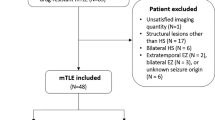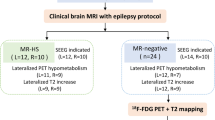Abstract
Purpose
Some patients with temporal lobe epilepsy (TLE) lack evidence of hippocampal sclerosis (HS) on MRI (HS-ve). We hypothesized that this group would have a different pattern of 2-deoxy-2-[F-18]fluoro-d-glucose (FDG)-positron emission tomography (PET) hypometabolism than typical mesial TLE/HS patients with evidence of hippocampal atrophy on magnetic resonance imaging (MRI) (HS+ve), with a lateral temporal neocortical rather than mesial focus.
Procedures
Thirty consecutive HS-ve patients and 30 age- and sex-matched HS+ve patients with well-lateralized EEG were identified. FDG-PET was performed on 28 HS-ve patients and 24 HS+ve patients. Both groups were compared using statistical parametric mapping (SPM), directly and with FDG-PET from 20 healthy controls.
Results
Both groups showed lateralized temporal hypometabolism compared to controls. In HS+ve, this was antero–infero–mesial (T = 17.13); in HS-ve the main clustering was inferolateral (T = 17.63). When directly compared, HS+ve had greater hypometabolism inmesial temporal/hippocampal regions (T = 4.86); HS-ve had greater inferolateral temporal hypometabolism (T = 4.18).
Conclusions
These data support the hypothesis that focal hypometabolism involves primarily lateal neocortical rather than mesial temporal structures in ‘MRI-negative PET-positive TLE.’








Similar content being viewed by others

References
Cascino GD, Jack CR, Jr, Parisi JE, et al. (1991) Magnetic resonance imaging-based volume studies in temporal lobe epilepsy: pathological correlations. Ann Neurol 30:31–36
Cook MJ (1994) Mesial temporal sclerosis and volumetric investigations. Acta Neurol Scand Suppl:152:109–114 discussion
Carne RP, O’Brien TJ, Kilpatrick CJ, et al. (2004) MRI-negative PET-positive temporal lobe epilepsy: a distinct surgically remediable syndrome. Brain 127:2276–2285
O’Brien TJ, Hicks RJ, Ware R, et al. (2001) The utility of a 3-dimensional, large-field-of-view, sodium iodide crystal-based PET scanner in the presurgical evaluation of partial epilepsy. J Nucl Med 42:1158–1165
Henry TR, Babb TL, Engel J, Jr, et al. (1994) Hippocampal neuronal loss and regional hypometabolism in temporal lobe epilepsy. Ann Neurol 36:925–927
Semah F, Baulac M, Hasboun D, et al. (1995) Is interictal temporal hypometabolism related to mesial temporal sclerosis? A positron emission tomography/magnetic resonance imaging confrontation. Epilepsia 36:447–456
O’Brien TJ, Newton MR, Cook MJ, et al. (1997) Hippocampal atrophy is not a major determinant of regional hypometabolism in temporal lobe epilepsy. Epilepsia 38:74–80
Cook MJ, Fish DR, Shorvon SD, Straughan K, Stevens JM (1992) Hippocampal volumetric and morphometric studies in frontal and temporal lobe epilepsy. Brain 115 (Pt 4):1001–1015
Pacia SV, Devinsky O, Perrine K, et al. (1996) Clinical features of neocortical temporal lobe epilepsy. Ann Neurol 40:724–730
Kim YK, Lee DS, Lee SK, et al. (2003) Differential features of metabolic abnormalities between medial and lateral temporal lobe epilepsy: quantitative analysis of (18)F-FDG PET using SPM. J Nucl Med 44:1006–1012
Luby M, Spencer DD, Kim JH, deLanerolle N, McCarthy G, (1995) Hippocampal MRI volumetrics and temporal lobe substrates in medial temporal lobe epilepsy. Magn Reson Imaging 13:1065–1071
Engel J, Jr, Brown WJ, Kuhl DE, et al. (1982) Pathological findings underlying focal temporal lobe hypometabolism in partial epilepsy. Ann Neurol 12:518–528
Henry TR, Sutherling WW, Engel J, Jr, et al. (1991) Interictal cerebral metabolism in partial epilepsies of neocortical origin. Epilepsy Res 10:174–182
Pozo M, Pascau J, Rojo P, et al. (2000) Correlation between FDG PET data and EEG dipole modeling. Clin Positron Imaging 3:173–2000
Akimura T, Yeh HS, Mantil JC, et al. (1999) Cerebral metabolism of the remote area after epilepsy surgery. Neurol Med Chir (Tokyo) 39:16–25
Spanaki MV, Kopylev L, DeCarli C, et al. (2000) Postoperative changes in cerebral metabolism in temporal lobe epilepsy. Arch Neurol 57:1447–1452
Chassoux F, Semah F, Bouilleret V, et al. (2004) Metabolic changes and electro-clinical patterns in mesio-temporal lobe epilepsy: a correlative study. Brain 127:164–174
Koutroumanidis M, Binnie CD, Elwes RD, et al. (1998) Interictal regional slow activity in temporal lobe epilepsy correlates with lateral temporal hypometabolism as imaged with 18FDG PET: neurophysiological and metabolic implications. J Neurol Neurosurg Psychiatry 65:170–176
Foldvary N, Lee N, Hanson MW, et al. (1999) Correlation of hippocampal neuronal density and FDG-PET in mesial temporal lobe epilepsy. Epilepsia 40:26–29
Matheja P, Kuwert T, Ludemann P, et al. (2001) Temporal hypometabolism at the onset of cryptogenic temporal lobe epilepsy. Eur J Nucl Med 28:625–632
Theodore WH, Kelley K, Toczek MT, Gaillard WD (2004) Epilepsy duration, febrile seizures, and cerebral glucose metabolism. Epilepsia 45:276–279
Spanaki MV, Kopylev L, Liow K, et al. (2000) Relationship of seizure frequency to hippocampus volume and metabolism in temporal lobe epilepsy. Epilepsia 41:1227–1229
Dlugos DJ, Jaggi J, O’Connor WM, et al. (1999) Hippocampal cell density and subcortical metabolism in temporal lobe epilepsy. Epilepsia 40:408–413
Theodore WH, Gaillard WD, De Carli C, Bhatia S, Hatta J (2001) Hippocampal volume and glucose metabolism in temporal lobe epileptic foci. Epilepsia 42:130–132
Diehl B, LaPresto E, Najm I, et al. (2003) Neocortical Temporal FDG-PET hypometabolism correlates with temporal lobe atrophy in hippocampal sclerosis associated with microscopic cortical dysplasia. Epilepsia 44:559–564
Nishio S, Morioka T, Hisada K, Fukui M (2000) Temporal lobe epilepsy: a clinicopathological study with special reference to temporal neocortical changes. Neurosurg Rev 23:84–89
Vielhaber S, Von Oertzen JH, Kudin AF, et al. (2003) Correlation of hippocampal glucose oxidation capacity and interictal FDG-PET in temporal lobe epilepsy. Epilepsia 44:193–199
O’Brien TJ, Hicks RJ, Ware R, et al. (2001) The utility of a 3-dimensional, large-field-of-view, sodium iodide crystal-based PET scanner in the presurgical evaluation of partial epilepsy. J Nucl Med 42:1158–1165
Casse R, Rowe CC, Newton M, Berlangieri SU, Scott AM (2002) Positron emission tomography and epilepsy. Mol Imaging Biol 4:338–351
Choi JY, Kim SJ, Hong SB, et al. (2003) Extratemporal hypometabolism on FDG PET in temporal lobe epilepsy as a predictor of seizure outcome after temporal lobectomy. Eur J Nucl Med Mol Imaging 30(04):581–587
Newberg AB, Alavi A, Berlin J, et al. (2000) Ipsilateral and contralateral thalamic hypometabolism as a predictor of outcome after temporal lobectomy for seizures. J Nucl Med 41:1964–1968
Delbeke D, Lawrence SK, Abou-Khalil BW, Blumenkopf B, Kessler RM (1996) Postsurgical outcome of patients with uncontrolled complex partial seizures and temporal lobe hypometabolism on 18FDG-positron emission tomography. Invest Radiol 31:261–266
Radtke RA, Hanson MW, Hoffman JM, et al. (1993) Temporal lobe hypometabolism on PET: predictor of seizure control after temporal lobectomy. Neurology 43:1088–1092
Theodore WH, Sato S, Kufta CV, Gaillard WD, Kelley K (1997) FDG-positron emission tomography and invasive EEG: seizure focus detection and surgical outcome. Epilepsia 38:81–86
Signorini M, Paulesu E, Friston K, et al. (1999) Rapid assessment of regional cerebral metabolic abnormalities in single subjects with quantitative and nonquantitative [18F]FDG PET: a clinical validation of statistical parametric mapping. Neuroimage 9:63–80
Van Bogaert P, Massager N, Tugendhaft P, et al. (2000) Statistical parametric mapping of regional glucose metabolism in mesial temporal lobe epilepsy. Neuroimage 12:129–138
Drzezga A, Arnold S, Minoshima S, et al. (1999) 18F-FDG PET studies in patients with extratemporal and temporal epilepsy: evaluation of an observer-independent analysis. J Nucl Med 40:737–746
Duarte PS, Zhuang H, Couturier O, Alavi A (2001) Does semi-quantitative analysis of FDG-PET have any additional value in the diagnosis of mesial temporal sclerosis? Arq Neuropsiquiatr 59:871–874
Acknowledgment
RC was supported by an Epilepsy Fellowship funded by an unrestricted research grant from Sanofi-Synthelabo Australia.
Author information
Authors and Affiliations
Corresponding author
Rights and permissions
About this article
Cite this article
Carne, R., Cook, M., MacGregor, L. et al. “Magnetic Resonance Imaging Negative Positron Emission Tomography Positive” Temporal Lobe Epilepsy: FDG-PET Pattern Differs from Mesial Temporal Lobe Epilepsy. Mol Imaging Biol 9, 32–42 (2007). https://doi.org/10.1007/s11307-006-0073-0
Published:
Issue Date:
DOI: https://doi.org/10.1007/s11307-006-0073-0



